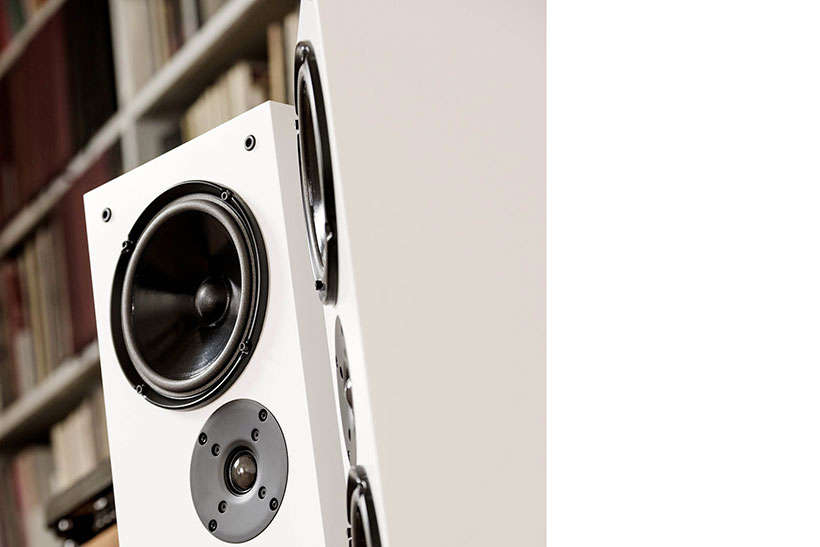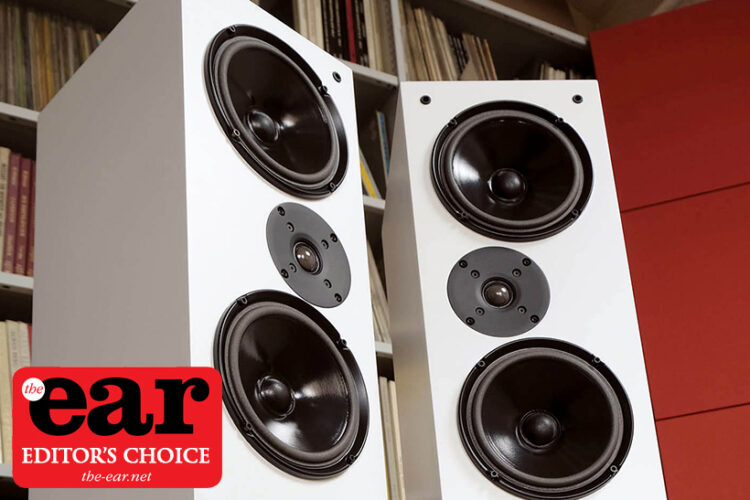I first met Kevin Scott in my early days at Hi-Fi Choice, he was at least as keen on valves and vinyl as I was and selling Audio Innovations amplifiers with Snell speakers from a house in Nottingham. When Snell stopped making its classic valve friendly designs Kevin was left needing a speaker that was efficient enough for the single ended triode amps that were starting to gain popularity, he found a few but none that really fitted the bill, and, importantly, stayed in production. So he developed the Auditorium which has formed the basis for a range of loudspeakers built around the same cabinet size and driver arrangement, an arrangement distinguished by the mid/treble/mid array with offset tweeter. There have been many iterations of this speaker but this has settled down to five models of which the R25A is the most affordable.
It’s unusual for a loudspeaker maker to stick with the same basic design for so many years unless that design happens to be an established classic such as a BBC LS3/5a. But there is a lot to be said for refining a design over an extended period of time, it allows the introduction of new components whilst sticking with a design that has proved itself and whose pros and cons are understood. I have lived with earlier versions of the Auditorium including an OBX model with external crossover and have always found them to be musically inspiring, they do what a hi-fi component should, let you immerse yourself in the music.

The R25A remains a highly valve friendly loudspeaker, its specified 94dB sensitivity is key to this but the second order, two-way crossover also helps as does the fact that throughout this speaker’s history it has always been developed to work with class A amps usually of the glass powered variety. Living Voice have also got to the stage where the majority of the components they use are made to their specification, this doesn’t just extend to crossover components and cabinets but also drive units. The drivers are made by Scanspeak to LV’s spec and consist of two 170mm mid/bass units with doped paper cones allied to a 26mm soft dome tweeter. The parts you can’t see are equally specialised, these include proprietary metallised polypropylene capacitors, non-inductive wire-wound resistors and air core inductors.
The cabinet is unusual in the way that it is supplied with a 140mm high plinth that’s the same shape and thus blends in with the design, especially if the woodwork is finished in matte black. The plinth has threaded inserts for spikes and LV supply small pieces of Blu-tack for the interface with the speaker. The cabinet construction is described as ‘750-density hardwood composite’ which is way of saying that it’s not made of MDF but they’re not saying precisely what it is. What they do say is that the box is finished inside and out with real wood veneer, a technique known as balancing that you don’t often encounter in contemporary loudspeaker cabinets.

The R25A like its predecessors stands a metre high on its stand but that is usually increased by around 25mm by spikes, this combined with a width of 215mm (just over 8inches) makes it easy to accommodate in most rooms. The rear firing port means it needs a bit of space behind it of course but there are few speakers that work close to a rear wall. It has bi-wire terminals and is not supplied with links in the expectation that users will use two lengths of cable, as I’m a single wirer myself I borrowed some links from another speaker but LV can make some up if they are needed.
Sound quality
I had some initial problems getting the bass under control when I first set up the R25A, almost regardless of amplifier and position the speakers seemed a little fulsom and lacking in definition. When this proved to be the case with some Triode Labs monoblocks I realised that it wasn’t an amp matching thing and took them off the Townshend Seismic Podiums and spiked them straight into the carpet. This had the desired effect but is at odds with the results I get with 99% of speakers where the bass becomes clearer, faster and more even on these isolation platforms. A finding that suggests the cabinet material is distinctly different to the norm. Set up conventionally the bass became tuneful, extended and while still anything but dry was well controlled with a range of amplifiers including the aforementioned single ended triodes (SETs).
But this is not a speaker that encourages a bass, mid and treble style analysis, it’s an unusually fluent and cohesive speaker that encourages musical indulgence. Especially if you play Tord Gustavsen Trio’s The Other Side on black wax, where the lyricisim of the piano playing and the nuances of interplay between the musicians are revealed in all their shimmering beauty. One of the most appealing qualities of this speaker is its ability to bring out the tonal colour of the instruments and voices it reproduces, it is richer than average in this regard but not in a tonally coloured way. You just hear more of the character in each element of a composition, they make many other speakers sound a little dry and restrained by comparison. So the bass on Radiohead’s ‘Decks Dark’ is well rounded but the overall feel of the production is distinctly grey and urban. The LVs deliver a good portion of the low end on the recording and the scale of image is equal to some rather more pricey designs.

With the aforementioned SET amps the harmonics are greatly enhanced compared to solid state amps and the midrange is sweetened or de-stressed in the way that you would expect, the result is almost as if digital becomes analogue such is the effortlessness and openness of the sound. It reminds me why I fell in love with valves in the first place and makes me think it’s about time I had a decent glass powered amp of my own. Even with Qobuz which is never as good as locally stored music but pretty good, the enjoyment factor remains high. l played a number of new tracks including ‘Formations’ by Hawktail with fiddle and double bass in a volk style and the speakers pulled out the lovely timbre of both instruments. I was using a Fidelice by Rupert Neve DAC at this point which has a clearcut, no frills pro sound but this combined with the liquid character of the speaker very nicely indeed.
When the triode amps had gone I found it hard to cope with the loss of valve charm in the system so installed the BorderPatrol DAC which has a valve in its power supply only but nonetheless delivers a sound that is quite beguiling in the right system. These speakers form a key part of such a system thanks to excellent timing which makes tracks like Steely Dan’s ‘The Boston Rag’ essential listening. This combo is particularly strong in the mid and treble, voices and guitars are very real and involving, as are many other instruments. One being the kora on Leifur James’ ‘Salaninam’ (A Louder Silence) which has so much of its innate character that it pops out of the system. But this isn’t a midrange strong speaker, it has a smooth but extended treble and extended bass that flows more easily than is usually the case. This is what makes the Auditorium so appealing, it’s not as incisive as is fashionable with more mainstream brands but makes up for it with a musicality that means any type of music is easy to access and enjoy. This comes down to high intrinsic coherence and some painstaking effort in the voicing process by someone who values musical fluidity above maximum definition. They have a relaxed presentation but not a lazy one, if you play music that jumps they’ll get you jumping, there’s no shortage of immediacy but you don’t get the etched presentation that’s quite fashionable in some quarters. Something that can sound impressive in the short term but ultimately gets in the way of the music, whereas the Living Voice R25A is all about opening up music so that you can understand and appreciate it. It’s about musical communication and enjoyment, since the Auditorium’s inception its maker has developed a keen interest in classical music and this will have influenced its evolution. But it still works exceptionally well with non classical forms of all kinds and can be wholeheartedly recommended to anyone wishing to discover new sonic worlds.


